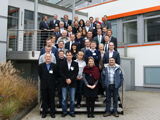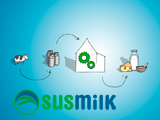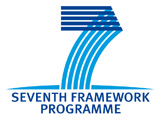EU-funded project SUSMILK - »Green Dairy«
Milk, quark and cheese are part of the daily food intake. How energy, water and carbon dioxide emissions can be saved in the production of such foodstuffs is what the just recently started EU Project SUSMILK shows. Under the leadership of Fraunhofer UMSICHT, 21 project partners are developing components that contribute to the sustainable processing of milk and a redesign of the dairy industry via their use in existing dairy infrastructures. For the next three years, the EU Project SUSMILK will be sponsored by the 7th Research Framework Program (FP7) of the European Commission.



Before milk gets from the cow into the bottle or carton, its processing is characterized by a multitude of heating and cooling processes. Even though the infrastructures necessary for this are most often not aligned with current sustainability standards, they often are utilized in the foodstuffs industry for up to 30 years. In the EU Project SUSMILK, Fraunhofer UMSICHT and the project partners are developing components for use in existing dairy infrastructures, with the objective of savings in energy, water and CO2 emissions.
Technical "greenification" in foodstuffs production
Based on five dairies of different sizes, an overall concept of a green dairy is being developed. This encompasses the development of technical components, their installation and testing at partner dairies, as well as process simulation and eco balance sheets. The goal is not a one-size-fits-all solution for dairies but rather an optimization of individual systems, customized to the situation of a dairy. There are different optimization options: "To save energy on-site, we utilize solar-thermal energy conversion through which we want to provide the thermal base load energy for the dairy. In addition, we use - for example - solar energy in high temperature solar panels for steam generation, which we couple with biomass boilers. In turn, we use the waste heat streams of the dairy to generate cold (absorption refrigeration). For this, we optimally adapt the systems to the respective dairy. Furthermore, heat pumps that feature both a high and a low temperature side help to optimally distribute the heat in the dairy", project manager Dr. Christoph Glasner explains the concept.
Milk concentrate saves water and energy
To save water and energy, Fraunhofer UMSICHT in one part of the project is specializing in the energy-efficient manufacturing of milk concentrate with improved quality. This measure has the potential to reduce both the transport energy and the tank sizes at the dairy. Standardized and dried concentrate is not only of interest for the manufacturing of products such as cheese, yoghurt and baked goods, but also for bridging the gap in case of supply shortages. In some regions of Europe, the supply with milk in part varies seasonally. With concentrated, dried milk, a storable product is at hand that is available the whole year in consistent quality and quantity.
Recycling of waste water and waste
The waste water inescapably generated in production and system cleaning has high organic loads. It is cleaned up via membrane technology and thus put to reuse in closed water circulation systems. Additionally, it is conceivable to generate energy in the form of biogas or bioethanol from waste treatment and to use it within the dairy for heat and electricity. Also, there is the option to recycle the universal material lactic acid from water streams.
Sponsor
For the next three years, SUSMILK will be sponsored by the 7th Research Framework Program (FP7) of the European Commission.
Last modified:
 Fraunhofer Institute for Environmental, Safety and Energy Technology UMSICHT
Fraunhofer Institute for Environmental, Safety and Energy Technology UMSICHT